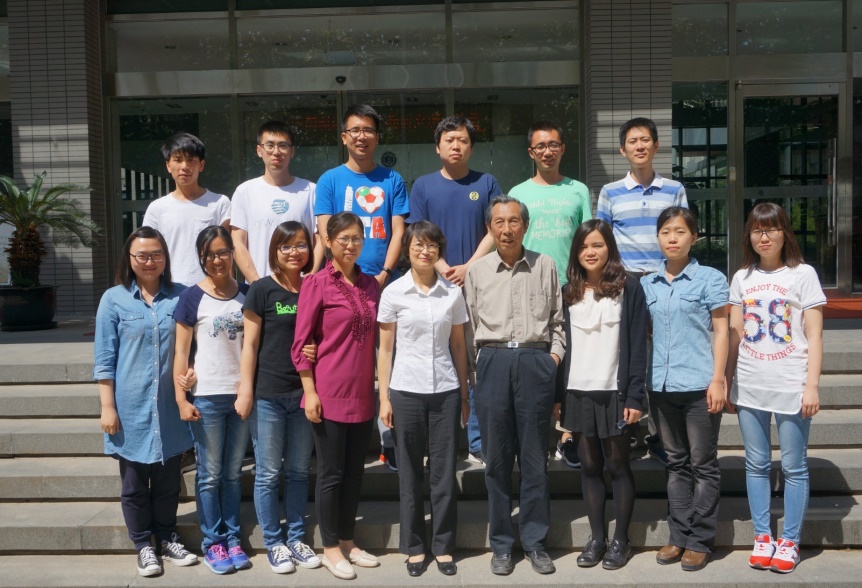Publication
1.Chen P, Zhang L, Guo X, Dai X, Liu L, Xi L, Wang J, Song L, Wang Y, Zhu Y, Huang L Huang Y*. Diversity, biogeography, and biodegradation potential of actinobacteria in the deep-sea sediments along the Southwest Indian Ridge. Front Microbiol, 2016, 7: 1340.
2.Cheng K, Rong X*, Huang Y* . Widespread interspecies homologous recombination reveals reticulate evolution within the genus Streptomyces. Mol Phylogenet Evol, 2016, 102: 246-254.
3.Liu M#, Liu N#, Shang F, Huang Y*. Activation and identification of NC-1, a cryptic cyclodepsipeptide from red soil-derived Streptomyces sp. FXJ1.172. Eur J Org Chem, 2016, 23: 3943-3948.
4.Liu N#, Song L#, Liu M#, Shang F, Anderson Z, Fox DJ, Challis GL*, Huang Y*. 2016. Unique post-translational oxime formation in the biosynthesis of the azolemycin complex of novel ribosomal peptides from Streptomyces sp. FXJ1.264. Chem Sci, 7(1): 482-488. doi:10.1039/c5sc03021h
5.Liu N., Song F., Shang F. and Huang Y.* 2015. Mycemycins A-E, new dibenzoxazepinones isolated from two different streptomycetes. Mar Drugs, 13(10): 6247-6258. doi:10.3390/md13106247
6.Huang B., Liu N., Rong X., Ruan J., Huang Y.* 2015. Effects of simulated microgravity and spaceflight on morphological differentiation and secondary metabolism of Streptomyces coelicolor A3(2). Appl Microbiol Biotechnol, 2015, 99(10): 4409-4422. doi:10.1007/s00253-015-6386-7
7.Guo X., Liu N., Li X., Ding Y., Shang F., Gao Y., Ruan J. and Huang Y.* 2015. Red soils harbour diverse culturable actinomycetes that are promising sources of novel secondary metabolites. Appl Environ Microbiol, 81: 3086-3103. doi:10.1128/AEM.03859-14.
8.Cheng K., Rong X., Pinto-Tomás A., Fernández-Villalobos M., Murillo-Cruz C. and Huang Y.*2015. Population genetic analysis of Streptomyces albidoflavus reveals habitat barriers to homologous recombination in the diversification of streptomycetes. Appl Environ Microbiol, 81: 966-975.
9.Rong X. and Huang Y.* 2014. Multi-locus sequence analysis: taking prokaryotic systematics to the next level. In Michael Goodfellow, Iain Sutcliffe and Jongsik Chun. Method Microbiol, 41: 221-251.
10.Rong X., Doroghazi J.R., Cheng K., Zhang L., Buckley D.H., Huang Y*. 2013. Classification of Streptomyces phylogroup pratensis (Doroghazi and Buckley, 2010) based on genetic and phenotypic evidence, and proposal of Streptomyces pratensis sp. nov. Syst Appl Microbiol, 36: 401-407.
11.Liu N. Shang F. Xi L. and Huang Y*. 2013. Tetroazolemycins A and B, two new oxazole-thiazole siderophores from deep-sea Streptomyces olivaceus FXJ8.012. Mar Drugs, 11: 1524-1533.
12.Rong X. and Huang Y.* 2012. Taxonomic evaluation of the Streptomyces hygroscopicus clade using multilocus sequence analysis and DNA-DNA hybridization, validating the MLSA scheme for systematics of the whole genus. Syst Appl Microbiol, 35:7-18.
13.Xi L., Ruan J. and Huang Y.* 2012. Diversity and biosynthetic potential of culturable actinomycetes associated with marine sponges in the China seas. Int J Mol Sci, 13: 5917-5932.
14.Zhang L., Xi L., Ruan J. and Huang Y.* 2012. Microbacterium marinum sp. nov., isolated from deep-sea water. Syst Appl Microbiol, 35: 81-85.
15.Xi L., Zhang L., Ruan J. and Huang Y.* 2012. Verrucosispora qiuiae sp. nov., isolated from mangrove swamp, and emended description of the genus Verrucosispora. Int J Syst Evol Microbiol, 62: 1564-1569.
16.Wang H., Liu N., Xi L., Rong X., Ruan J. and Huang Y.* 2011. Genetic screening strategy for rapid access to polyether ionophore producers and products in actinomycetes. Appl Environ Microbiol, 77: 3433-3442.
17.Rong X., Liu N., Ruan J. and Huang Y.* 2010. Multilocus sequence analysis of Streptomyces griseus isolates delineating intraspecific diversity in terms of both taxonomy and biosynthetic potential. Antonie van Leeuwenhoek, 98: 237-248.
18.Rong X. and Huang Y.* 2010. Taxonomic evaluation of the Streptomyces griseus clade using multilocus sequence analysis and DNA-DNA hybridization, with proposal to combine 29 species and three subspecies as 11 genomic species. Int J Syst Evol Microbiol, 60: 696-703.
19.Gao P. and Huang Y.* 2009. Detection, distribution, and organohalogen compound discovery implications of the reduced flavin adenine dinucleotide-dependent halogenase gene in major filamentous actinomycete taxonomic groups. Appl Environ Microbiol, 75: 4813-4820.
20.Rong X., Guo Y. and Huang Y.* 2009. Proposal to reclassify the Streptomyces albidoflavus clade on the basis of multilocus sequence analysis and DNA-DNA hybridization, and taxonomic elucidation of Streptomyces griseus subsp. solvifaciens. Syst Appl Microbiol, 32: 314-322.
21.Qiu D., Ruan J. and Huang Y.* 2008. Selective isolation and rapid identification of members of the genus Micromonospora. Appl Environ Microbiol, 74: 5593-5597.
22.Guo Y. Zheng W., Rong X. and Huang Y.* 2008. A multilocus phylogeny of Streptomyces griseus 16S rRNA gene clade: use of multilocus sequence analysis for streptomycete systematics. Int J Syst Evol Microbiol, 58: 149-159.

